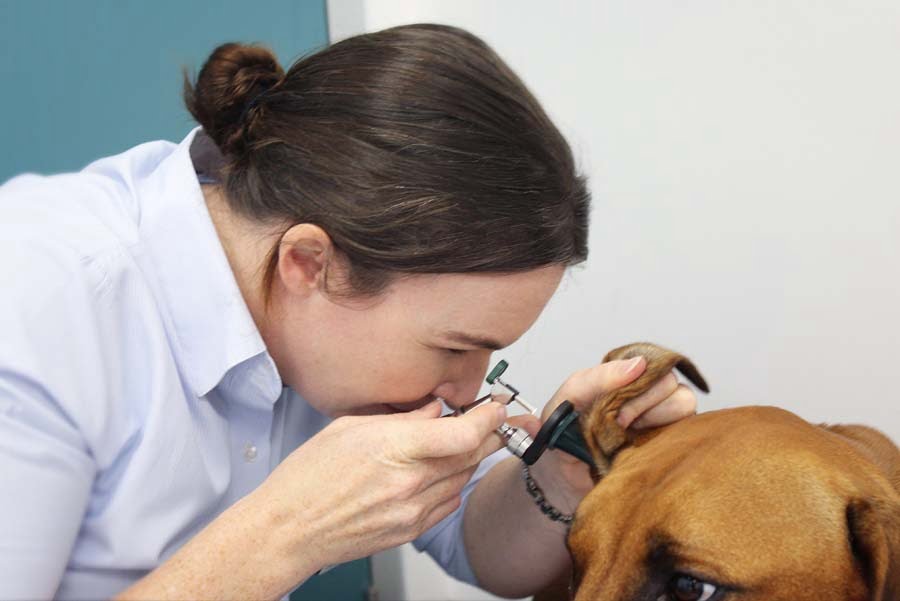A Turramurra Vet Pet Care Article
How to Manage and Prevent Dog Ear Problems

How to Manage and Prevent Dog Ear Problems
by Dr Gretta Howard – Senior Veterinarian
What is otitis externa?
Dog ear infections, known as otitis externa, are extremely common, particularly in spring and summer in Sydney due to the heat and humidity. Ear infections can either be due to yeast or bacteria, or a combination of both and can be extremely painful, causing an array of clinical signs including head shaking, scratching or a bad smell from the ears.
Dogs with very hairy ear canals or floppy ears are generally more prone than dogs with hairless upright ears. This is because there is less airflow in floppy-eared or hairy-eared dogs, which leads to damp, moist conditions that micro-organisms tend to flourish in.
In addition to this, recurrent ear infections are a feature of allergic skin disease as the ears are an extension of the skin, so besides treating the infection, the allergic skin disease also needs to be managed.
A dog’s external ear canal is just an extension of the skin and as the skin contains normal “flora” (bacteria) on the surface, so does the ears. However, when the ear canal’s conditions become too moist (e.g. swimming) or traumatised from scratching (e.g. itchy from allergic skin disease) and the defense barrier is damaged, these bacteria/yeast multiply and cause an infection. The inflammation and discharge created produces a large amount of smelly discharge in the ear(s).
Are my dog’s ears really different to ours?
Dog ear anatomy is very different to the human ear. Humans have a short horizontal ear canal, while dogs have a deep horizontal ear canal which then joins up with a vertical ear canal in an ‘L-shape’. It is a lot further down to the ear drum when compared with humans (which is one reason vets cannot measure the body temperature this way). Coupled with hair, darkness, poor ventilation and moisture, bacteria and yeast love to take up residence in your dog’s ears!
What are the clinical signs of a dog ear infection?
It is really important that pet owners know how to recognise a dog ear infection early so that veterinary care can be sought promptly.
Dog owners should regularly check their dog’s ears for signs of redness, pain and an excessive ear discharge, which returns quickly after an ear clean. Signs of a dog ear infection include head shaking, a dark brown or yellow discharge, a bad smell from the ear.
How is an ear infection diagnosed?
In order to determine the severity and type of infection present, your vet will usually recommend that a sample of the discharge from the affected ear(s) is checked under the microscope – this is known as ear cytology.
A cotton bud is placed into the ear and then rolled onto a microscope slide and a special staining process allows the vet to check for bacteria and yeast. This process guides the decision-making process in how to treat the ear infection.
For particularly severe or recurrent bacterial infections known as rod bacterial infections, an ear swab may be sent for laboratory testing to determine which antibiotic the infection is susceptible to.
Your vet will also investigate the cause of the ear infection and if a foreign body is suspected (e.g. grass seed) as the cause of the pain and discharge, then an ear examination with a special instrument called an otoscope may be required. Sometimes sedation or anaesthesia is required for particularly painful ears.
How is my dog’s ear infection treated?
There are 5 important steps to take when treating an ear infection:
- Flushing the ear –
It is important to remove the discharge and debris before applying topical ear treatment to treat the infection. If ears are not adequately cleaned, then the anti-microbials cannot do their job of tackling the infection, as the discharge acts as a substrate for the infection to persist.Dogs with an ear infection are often painful and in severe cases your vet may need to sedate or even anaesthetise your dog for welfare reasons in order to flush out the infection properly in the external ear canal. - Topical ear treatment –
In most cases, your vet will prescribe a topical ointment to place in the ears to kill the offending bacteria or yeast. Even if the infection looks as though it has disappeared after a few days of treatment, it is imperative that treatment is continued until the end of the prescribed course to reduce the risk of bacterial resistance. - Oral anti-inflammatory medication –
For painful or very inflamed ears, your vet will frequently prescribe oral corticosteroids or anti-inflammatories to reduce the inflammation associated with the ear infection. - Recheck appointment –
A follow-up appointment is important at the end of the course of prescribed medication to ensure the infection has disappeared completely. This can be confirmed by repeating the ear cytology under the microscope. If there is still evidence of infection present, your vet may choose to extend the course of medication, switch to a different anti-microbial or submit a culture swab to the laboratory to further investigate. - Ear maintenance –
Dogs that have had multiple ear infections in succession will benefit from an ear maintenance program which may involve regular ear cleaning, topical ear treatments given once or twice weekly, aiming to reduce the external ear canal inflammation and therefore reduce the likelihood of a secondary infection.
What is the correct ear cleaning technique for my dog?
Using a veterinary-approved ear cleaner designed for dog ears helps to break down and remove the discharge present in the ear and maintain the pH at the right level in order to reduce bacterial and yeast overgrowth.
Keep it positive! It is important to pair ear cleaning with delicious treat rewards, given intermittently throughout the clean, that your dog finds irresistible! That way we are positively reinforcing ear cleaning to reduce fear and anxiety that can sometimes be associated with ear cleaning. Gauze swabs can be purchased in bulk at Turramurra Veterinary Hospital or online.
Dog ear cleaning instructions
- Moisten several gauze swabs with a veterinary-recommended ear cleaner (e.g. Otoflush, Epiotic, PAW)
- Use individual wet gauze swabs to gently wipe the inside of the ear flap first, to slowly introduce your dog to the ear cleaning procedure
- Move inside the external ear canal with moistened swabs, removing ear wax and debris, using a new gauze swab each time
- Pour some ear cleaner inside ear using ‘slide’ technique, which means holding the ear flap up and squirting the ear cleaning onto the top of the ear flap, to allow it to gently slide into the external ear canal (avoid squirting the ear cleaner at high speed deep into canal which can be noisy and uncomfortable for your dog)
- Massage ear base (you should hear a squelching sound!)
- Move away, take your dog off leash and allow your dog to shake the excess fluid out of the ear. This will also remove debris deep within the ear canal.
- Use dry gauze swabs to remove any excess ear cleaner and debris
- Repeat this technique with the other ear
Plucking the hair from hairy dogs’ ears does not usually help and is quite painful so is usually not recommended. Shaving the hair from around the ear and inside the pinna can help improve airflow and keep the ears dry. Be very careful not to accidentally nick the ear in the process though!
If you are not confident in performing a proper ear clean, book an appointment with one of our vets for a demonstration.
If your dog’s ears seem unusually painful, inflamed or have an excessive discharge, a veterinary consultation is recommended, as it is possible that an ear infection is present.
What happens if a dog ear infection is left untreated?
If ear infections are left untreated, apart from the discomfort your dog will experience, the ear canals can be permanently damaged or the chronic inflammation can cause permanent narrowing of the ear canals (stenosis), meaning that the chances of clearing the infection are reduced. Occasionally external ear infections can cause ear drum rupture, which can then cause a middle ear disease and interfere with your dog’s balance. Sometimes dogs may even need surgery to remove the whole ear canal if treatment is unsuccessful in these chronic cases.
How can ear infections in dogs be prevented?
Swimming can cause water to become trapped deep within the external ear canal, so it is important to dry your dog’s ears as thoroughly as possible when your dog swims or has a bath.
If your dog is prone to allergic skin disease, then he or she will also be more prone to developing ear disease. Typically, allergic skin disease is either caused by food or environmental allergens. In dogs, food allergy makes up approximately 5% of allergic skin disease cases, whereas environmental allergens, known as atopic dermatitis or atopy, is far more common.
If a food allergy is suspected, then a food elimination diet trial will be recommended. Further information is available on our website on food allergies and on allergic skin disease.

